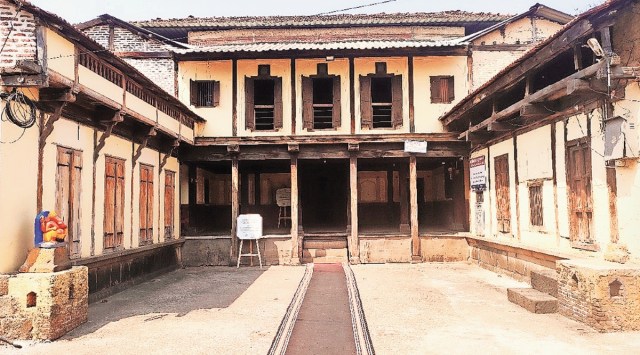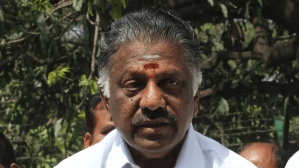Glimpse of 18th-century Peshwa era at this newly restored wada in Satara
Sixth-generation descendants of Nana Fadnavis, they took the step as part of their efforts to tell the story of the structure as a heritage legacy of the Maratha Empire, as well as to better acquaint the public with the towering personality of Balaji Janardhan Bhanu or Nana Fadnavis -- a prominent statesman who once served as the chief accountant of the Peshwas.
 The wada at Wai was built for Nana Fadnavis, a minister of the Maharatha empire at the peak of its power. (Express)
The wada at Wai was built for Nana Fadnavis, a minister of the Maharatha empire at the peak of its power. (Express)Around 230 kilometers from Mumbai — or a five-hour drive away — is situated the 18th-century palace (wada) of Peshwa statesman Nana Fadnavis. Located in Menavli, Wai taluka, near Satara, the palace was opened for tourists a few months back following the pandemic-induced lockdown, and after a decade of restoration work on the part of the Menavlikar family, who own the property.
Sixth-generation descendants of Nana Fadnavis, they took the step as part of their efforts to tell the story of the structure as a heritage legacy of the Maratha Empire, as well as to better acquaint the public with the towering personality of Balaji Janardhan Bhanu or Nana Fadnavis — a prominent statesman who once served as the chief accountant of the Peshwas.
Says Nitin Madhavrao Menavlikar, one of the owners of the palace: “Wai is among the few places where his (Nana Fadnavis’s) property has remained in entirety till date. The objective of the restoration was to preserve its heritage legacy, and to tell its story to as many people as possible.”
Following the Third Battle of Panipat in 1761, Nana Fadnavis actively worked toward reinstating the Maratha Empire. During his lifetime, Nana Fadnavis set up properties across the country, but few remain with his descendants today.
The wada at Wai was used as a holiday or weekend home by Nana Fadnavis and his family, according to records of entry and exit at the palace. After Nana Fadnavis’s demise in 1800, his last wife, Jeeubai, decided to settle here, according to their descendants.
The first phase of the restoration process, which included major structural work, was initiated in 2009 and was completed in installments over the next decade. In late 2019, the wada was thrown open to public before being shut again in the wake of the pandemic. Presently, the family has set the ball rolling for the second phase of restoration, which includes setting up of a museum and an art gallery of Maratha wall paintings within the palace. However, the process has been “financially strenuous”.
The 40,000-sqft Nana Fadnavis wada is situated within a complex of about two acres of land, and is surrounded by over 50 acres of private farmland owned by the Menavlikar family. Since the concept of rooms was different from the time of the wada’s construction, its present-day owners quantify the space within the structure in terms of multi-purpose squares (verandas). There are six such squares which are partially covered, each leading to multi-purpose rooms. Two of these were opened to tourists after the first phase of restoration. Over the next couple of years, another square will be opened for visitors while the family will retain a few others for private use.
Walls in many rooms and squares bear paintings from the 18th century, when the palace was constructed, but some have eroded over time. The existing paintings will be restored, while those that are lost will be digitally replicated and installed without damaging the original structure or walls.
“We want to simulate the 18th-century era for tourists, and are using modern-day technology to take visitors back in time while site-seeing. Visitors can log into an audio guide during their tour. Each room will have a QR code that can be scanned and audio information about its utility will be available on their smartphones,” Nitin Menavlikar said. The family also plans to display a map of India plotting locations where Nana Fadnavis created public and private infrastructure during his lifetime, such as temples, bridges, and drinking water facilities.
Though the palace gets visitors from Satara and neighbouring regions over the weekend, it is awaiting visitors from Metro cities across Maharashtra. An interesting component of the wada is the “Bell Shrine”, which was considered a victory symbol by Nana Fadnavis. Says Menavlikar, “In those days, each time the Marathas defeated the Europeans in a battle, they would pull down church bells and bring them back home. Nana Fadnavis installed these symbols of victory and pride in full view of the visitors and residents of the palace, in what we have called a Bell Shrine. The bell at Nana Fadnavis palace is engraved with the year it was made – 1707 — by the Portuguese. The writing is in Latin.”
As part of the second phase of restoration, the family also plans to recreate the record room, or the Modi-daftar, displaying documents and letters that are available with the family. “Because of Nana Fadnavis’s discipline in maintaining records, over 4 crore documents are available from the Peshwa Daftar. He was also known for facilitating the maximum number of peace treaties during his time. Most of these documents have been acquired by the government.
Some private letters, or correspondences written in the Modi script, are still with the family. These will be displayed in the record room,” says Menavlikar.
The restoration work is being carried out by Mumbai-based firm Vaastu Vidhaan. Rahul Chemburkar, heritage architect from Vaastu Vidhaan, says, “We are following all heritage conservation ethics such as using ‘like-to-like’ material, recreating structurally lost aspects and reinstating the original look and feel of the place. It has sustained over two centuries, and the aim of the restoration is to preserve it for another 150 years or more.”












